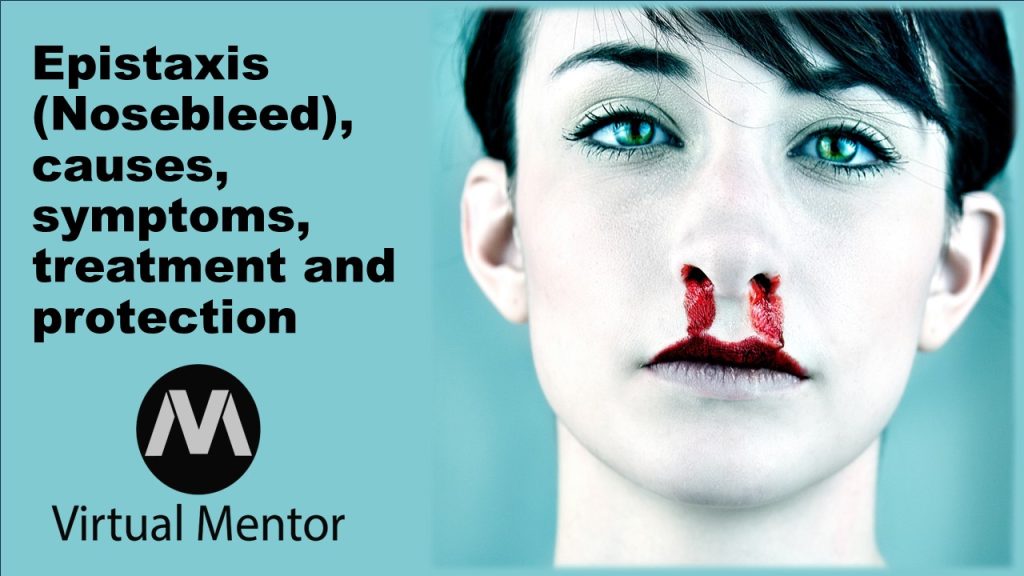Introduction:
What is Epistaxis?
Epistaxis is a medical term used for nosebleeds. Epistaxis commonly known as nosebleeds is a medical condition in which blood is released from inside the nose due to acute hemorrhage from the nose and nasal pathways i.e., nostrils, nasal cavity, or nasopharyngeal region. It occurs when the blood vessels in the nasal passageways rupture, and results in hemorrhage and bleeding from the nose. It is a very frequent emergency department complaint, especially with reference to children.
Etymology:
The word Epistaxis comes from two Greek words i.e., “epi” means upon or in, and “stazein” means to drip. It means dripping of blood from the nose.
Types of Epistaxis:
Anterior Epistaxis:
- It occurs when nosebleeds from its front.
- In the front part of the nose blood vessels are very delicate and more fragile.
- It is a very common type of epistaxis.
- It is usually less severe.
Posterior Epistaxis:
- It occurs when nosebleeds from its back parts.
- It is less common than anterior epistaxis.
- It is more serious and very difficult and challenging to manage.
Risk factors for the epistaxis:
The more commonly affected people are;
- Children (due to sports injuries)
- Patient having anxiety
- Patients having hypertension
- Patients having blood-related disorders, I.e., hemophilia.
Site of epistaxis:
About 90 % of the epistaxis occurs at the little area of the nose. It also occurs in the nasopharynx, above the level of the middle turbinate, below the level of the middle turbinate, and posterior part of the nasal cavity.
Causes of Epistaxis:
Epistaxis is a multifactorial issue and plenty of factors are responsible for nosebleeds. Knowing about these factors is very important because it is crucial for its management. The following factors are major causes of nosebleeds and they can be divided into the following major categories.
Local Causes:
- Trauma: Physical injuries due to some accidents (resulting in nasal bone fractures), fingernails, a blow to the face, a fall on the nose, or hitting of the nose with some hard surface also results in nosebleeds.
- Rhinoliths: These are mineralized foreign bodies in nostrils, which become large and undiscoverable.
- Invasion: Such as maggots and larvae.
- Neoplasms of the nose: These are the abnormal growth of the nose which may be benign (haemangioma, papilloma) and malignant (carcinoma, sarcoma).
- Mediastinal compression: Tumors in mediastinum
- Deviated nasal septum change: These may be due to atmospheric change or due to angiofibroma.
Infectious causes:
The most common infections causing nosebleeds are;
- Viral rhinitis
- Diphtheria
- Sinusitis (tissue lining the nasal cavities swollen and become inflamed due to infections).
- Influenza
- Rheumatic fever
- Dengue fever
- Infectious mononucleosis
General Causes:
- Cardiovascular system abnormalities: Such as hypertension, mitral stenosis, & arteriosclerosis.
- Blood disorders: Aplastic anemia, leukemia, thrombocytopenia, hemophilia, scurvy, & vitamin K deficiency.
- Liver disorders: Liver cirrhosis, deficiency of blood clotting factors,
Idiopathic causes:
- Dry nasal mucosa:
- Nose picking
- Vascular fragility
Drug abuses:
- Overuse of aspirin
- Anticoagulant therapy
Atmospheric causes:
- Dry Air: Dryness in air and less humidity have major impacts on the nasal membranes. Because during inspiration air directly affects the blood vessels in nasal passageways making them more fragile.
- Nasal Irritants: Sometimes irritants like tobacco smoke, other smoke, smog, polluted air, and chemical fumes, can cause blood vessels in the nose to rupture.
- Allergens: Environmental allergens pollen, dust, and smoke in hypersensitive people also increase the chances of epistaxis.
Symptoms of Epistaxis:
It is very simple to indicate epistaxis because it has very clear signs such as;
- Blood Dripping: This is a necessary sign of epistaxis, in which blood is dripping from the nose (Anterior Epistaxis) or coming from the throat (Posterior Epistaxis).
- Nasal Congestion: After the onset of the epistaxis, the nose appears to be filled.
- Blood taste in the mouth: In the case of Posterior epistaxis the blood falls into the back of the mouth and it make its taste in the mouth.
- Difficulty in Breathing: The nose appears to be filled and there is difficulty in breathing.
Complications:
- Severe bleeding
- Anemia
- Shock
- Infections
- Sinusitis
- Hypotension
- Septal hematoma
- Septal perforations
- Aspiratory pneumonia
- Airway obstruction
- Difficult breathing
Patient History Before Treatment:
- Mode of onset: Means spontaneous, trauma, sports injury, accidental injury or fingernail trauma.
- Duration:
- Frequency:
- Amount of blood loss
- Physical observation of the sides of the nose
- Anterior or posterior
- Any ailment, infections, blood disorders, hypertension, etc.
- Drug use such as aspirin or anticoagulants
Treatment options:
- First Aid: After the onset of epistaxis, when anybody feels blood dripping off from the nose, there must be taken two immediately steps;
a. Pinching nose from both sides: This will reduce blood release from blood vessels.
b. Leaning your head forward slightly: This will prevent blood from falling into the throat. - Hospitals: At Health Care Centers there must be three important steps should be taken according to the severity of the issue.
a. Nasal packing: Anterior nose packing/posterior nose packing
b. Cauterization: endoscopic cauterization
c. Submucous resection operation
d. Medication:
i. Checking of Vital signs, Blood pressure, Pulse rate, and respiratory rate.
ii. Intravenous fluids
iii. Mild sedation
iv. Blood transfusion if needed
v. Antibiotics to prevent sinusitis
Preventions:
To minimize epistaxis these things will help you a lot.
- Use masks and proper hygiene.
- Use humifies to reduce indoor dryness of the air.
- Avoid standing in unhealthy air for a longer period of time.
- Whenever you are cleaning your nostrils blow gently and avoid waxing in the nostrils.
- Try to maintain your normal health parameters.
Conclusion:
Epistaxis (nosebleed) results from a number of environmental, biological, and other factors including, primary and secondary ailments, dryness of the air, trauma, irritants, and unhealthy atmospheric conditions. The main indication of Epistaxis is the dripping of blood from the nose. Immediate treatment is to pinch your nostrils with your fingers and lean your head forward. If the nosebleeds not stopping move toward a nearby healthcare center. Maintain good health and live in a hygienic environment. This will reduce risk factors for the epistaxis.
Stay Blessed.

